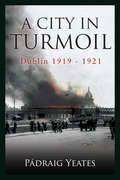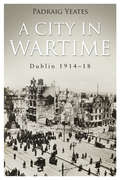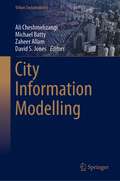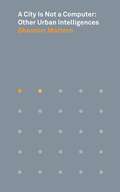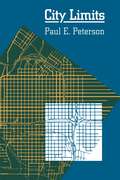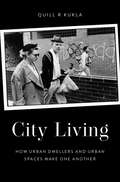- Table View
- List View
A City in Turmoil – Dublin 1919–1921: The War of Independence
by Padraig YeatesDublin was the cockpit of the Irish Revolution. It was in the capital that Dáil Éireann convened and built an alternative government to challenge the authority of Dublin Castle; it was where the munitions strike that crippled the British war effort in 1920 began and it was where rival intelligence organisations played out their deadly game of cat and mouse. But it was also a city where ambushes became a daily occurrence and ordinary civilians were caught in the deadly crossfire. Restrictions on travel, military curfews and the threat of internment would ultimately make normal life impossible.As in his previous work, A City in Wartime, Pádraig Yeates uncovers unknown and neglected aspects of the Irish Revolution, including the role that the Bank of Ireland played in keeping the city solvent, the rise of the Municipal Reform Association to challenge the hegemony of Sinn Féin and Labour, how one of Ireland's leading businessmen started out as a bagman for Michael Collins and how, ultimately, many Dubliners found it easier to sympathise with the fight for the Republic than participate in or pay for it.
The City in Urban Poverty (EADI Global Development Series)
by Charlotte Lemanski Colin MarxThe contributors respond to the absence of critical debate surrounding the ways in which spaces of the city do not merely contain, but also constitute, urban poverty. The volume explores how the spaces of the city actively produce and reproduce urban poverty.
A City in Wartime – Dublin 1914–1918: The Easter Rising 1916 (New Perspectives On Modern Jewish History Ser. #1)
by Pádraig YeatesThis fascinating history looks at how the lives of ordinary Dubliners were affected by these three major events Why did so many working-class Dublin men join the British Army? How did the city’s 92,000 Protestants fare in this turbulent time? Dubliners fought on both sides in the Easter Rising. What were their motivations? How did Sinn Féin and the Catholic Church marginalise Labour in the battle for political control of the city after the Rising? Why did so many Dubliners benefit from the British war effort, especially tenement families and working women? Pádraig Yeates discusses each of these in detail and also looks at how the population fed itself during hard times, the impact of the war on music halls, child cruelty, prostitution, public health and much more. The Dublin as we know it was shaped in these years. And this captivating book takes you back to those times to shine a new light on the city today.
City Indians in Spain's American Empire: Urban Indigenous Society in Colonial Mesoamerica and Andean South America, 1530-1810 (pdf) (First Nations and the Colonial Encounter)
by Dana Velasco MurilloThis volume, the first of its genre in English, brings together the pioneering work of scholars of urban Indians of colonial Latin America. An important, but understudied segment of colonial society, urban Indians composed a majority of the population of Spanish America's most important cities. The geographic range, chronological scope, and thematic content of urban native studies is addressed by examining such topics as the role of natives in settling frontier regions, interethnic relations, notaries and chroniclers, and the continuation of indigenous governance. In spanning the entirety of the colonial period, the persistence and the creation of urban Indian identities and their contributions to colonial society is brought to the fore. Scholarly contributions include chapters by Susan Schroeder, "Whither Tenochtitlan? Chimalpahin and Mexico City, 15931631" and David Cahill, "Urban Mosaic: Indigenous Ethnicities in Colonial Cuzco". The volume opens with commentary by John K. Chance, pioneer scholar of urban Indians in Latin America and author of the highly praised Race and Class in Colonial Oaxaca and is summed up in "Concluding Remarks" by Kevin Terraciano, author of the widely acclaimed The Mixtecs of Colonial Oaxaca: Nudzahui History. The diverse themes, time periods, and geographic regions discussed herein make this illustrated book essential reading for all those engaged in colonial and indigenous studies.
City Information Modelling (Urban Sustainability)
by Ali Cheshmehzangi Michael Batty Zaheer Allam David S. JonesThis is the first book focused on City Information Modelling (CIM) that puts together a collection of recent studies related to concepts and trends in CIM, application and digitization processes/methods, and frameworks and practices of CIM. This emerging topic is important to various research and practice under sectors of the built environment, civil engineering, urban planning, urban design, and urban management. CIM aligns well with smart cities, data-driven urban analytics and optimization, information-based city planning, and future development paradigms. City Information Modelling provides global case study examples in three parts. At first, the contributors offer several examples of ‘Concepts and Trends’, where CIM is explored further in urban management, urban sustainability, and big data studies. In the second part, the book offers various examples of application and digitization processes or methods related to urban planning and design practices. In the third part, the contributors delve into several examples of CIM frameworks and practices critical to contemporary research, planning and design paradigms, and future practices. This collection is a niche resource for various stakeholders, particularly urban scientists, urban analytics, urban practitioners, and researchers. It will also be a valuable collection for those who work with information-based models, urban optimization models, and big data analytics, particularly from policy and practice perspectives. The findings of this collection help direct future research in CIM and suggest opportunities for big-data urban research, integrated urban models, and holistic frameworks in sustainable cities, smart cities, and future cities.
The City is an Ecosystem: Sustainable Education, Policy, and Practice (Advances in Urban Sustainability)
by Deborah Mutnick Margaret Cuonzo Carole Griffiths Timothy Leslie Jay M. ShuttleworthThe City is an Ecosystem maps an interdisciplinary, community-engaged response to the great ecological crises of our time—climate change, biodiversity loss, and social inequality—which pose particular challenges for cities, where more than half the world’s population currently live. Across more than twenty chapters, the three parts of the book cover historical and scientific perspectives on the city as an ecosystem; human rights to the city in relation to urban sustainability; and the city as a sustainability classroom at all educational levels inside and outside formal classroom spaces. It argues that such efforts must be interdisciplinary and widespread to ensure an informed public and educated new generation are equipped to face an uncertain future, particularly relevant in the post-COVID-19 world. Gathering multiple interdisciplinary and community-engaged perspectives on these environmental crises, with contemporary and historical case study discussions, this timely volume cuts across the humanities and social and health sciences, and will be of interest to policymakers, urban ecologists, activists, built environment professionals, educators, and advanced students concerned with the future of our cities.
A City Is Not a Computer: Other Urban Intelligences (Places Books #2)
by Shannon MatternA bold reassessment of "smart cities" that reveals what is lost when we conceive of our urban spaces as computersComputational models of urbanism—smart cities that use data-driven planning and algorithmic administration—promise to deliver new urban efficiencies and conveniences. Yet these models limit our understanding of what we can know about a city. A City Is Not a Computer reveals how cities encompass myriad forms of local and indigenous intelligences and knowledge institutions, arguing that these resources are a vital supplement and corrective to increasingly prevalent algorithmic models.Shannon Mattern begins by examining the ethical and ontological implications of urban technologies and computational models, discussing how they shape and in many cases profoundly limit our engagement with cities. She looks at the methods and underlying assumptions of data-driven urbanism, and demonstrates how the "city-as-computer" metaphor, which undergirds much of today's urban policy and design, reduces place-based knowledge to information processing. Mattern then imagines how we might sustain institutions and infrastructures that constitute more diverse, open, inclusive urban forms. She shows how the public library functions as a steward of urban intelligence, and describes the scales of upkeep needed to sustain a city's many moving parts, from spinning hard drives to bridge repairs.Incorporating insights from urban studies, data science, and media and information studies, A City Is Not a Computer offers a visionary new approach to urban planning and design.
A City Is Not a Computer: Other Urban Intelligences (Places Books #2)
by Shannon MatternA bold reassessment of "smart cities" that reveals what is lost when we conceive of our urban spaces as computersComputational models of urbanism—smart cities that use data-driven planning and algorithmic administration—promise to deliver new urban efficiencies and conveniences. Yet these models limit our understanding of what we can know about a city. A City Is Not a Computer reveals how cities encompass myriad forms of local and indigenous intelligences and knowledge institutions, arguing that these resources are a vital supplement and corrective to increasingly prevalent algorithmic models.Shannon Mattern begins by examining the ethical and ontological implications of urban technologies and computational models, discussing how they shape and in many cases profoundly limit our engagement with cities. She looks at the methods and underlying assumptions of data-driven urbanism, and demonstrates how the "city-as-computer" metaphor, which undergirds much of today's urban policy and design, reduces place-based knowledge to information processing. Mattern then imagines how we might sustain institutions and infrastructures that constitute more diverse, open, inclusive urban forms. She shows how the public library functions as a steward of urban intelligence, and describes the scales of upkeep needed to sustain a city's many moving parts, from spinning hard drives to bridge repairs.Incorporating insights from urban studies, data science, and media and information studies, A City Is Not a Computer offers a visionary new approach to urban planning and design.
The City Is the Factory: New Solidarities and Spatial Strategies in an Urban Age
Urban public spaces, from the streets and squares of Buenos Aires to Zuccotti Park in New York City, have become the emblematic sites of contentious politics in the twenty-first century. As the contributors to The City Is the Factory argue, this resurgent politics of the square is itself part of a broader shift in the primary locations and targets of popular protest from the workplace to the city. This shift is due to an array of intersecting developments: the concentration of people, profit, and social inequality in growing urban areas; the attacks on and precarity faced by unions and workers' movements; and the sense of possibility and actual leverage afforded by local politics and the tactical use of urban space. Thus, "the city"—from the town square to the banlieu—is becoming like the factory of old: a site of production and profit-making as well as new forms of solidarity, resistance, and social reimagining.We see examples of the city as factory in new place-based political alliances, as workers and the unemployed find common cause with "right to the city" struggles. Demands for jobs with justice are linked with demands for the urban commons—from affordable housing to a healthy environment, from immigrant rights to "urban citizenship" and the right to streets free from both violence and racially biased policing. The case studies and essays in The City Is the Factory provide descriptions and analysis of the form, substance, limits, and possibilities of these timely struggles.ContributorsMelissa Checker, Queens College and the Graduate Center of the City University of New York; Daniel Aldana Cohen, University of Pennsylvania; Els de Graauw, Baruch College, City University of New York; Kathleen Dunn, Loyola University ChicagoShannon Gleeson, Cornell University; Miriam Greenberg, University of California, Santa Cruz; Alejandro Grimson, Universidad de San Martín (Argentina); Andrew Herod, University of Georgia; Penny Lewis, Joseph S. Murphy Institute for Worker Education and Labor Studies, City University of New York; Stephanie Luce, Joseph S. Murphy Institute for Worker Education and Labor Studies, City University of New York; Lize Mogel, artist and coeditor of An Atlas of Radical Cartography; Gretchen Purser, Maxwell School of Citizenship and Public Affairs, Syracuse University
City Life from Jakarta to Dakar: Movements at the Crossroads
by AbdouMaliq SimoneCity Life from Jakarta to Dakar focuses on the politics incumbent to this process – an "anticipatory politics" – that encompasses a wide range of practices, calculations and economies. As such, the book is not a collection of case studies on a specific theme, not a review of developmental problems, nor does it marshal the focal cities as evidence of particular urban trends. Rather, it examines how possibilities, perhaps inherent in these cities all along, are materialized through the everyday projects of residents situated in the city and the larger world in very different ways.
City Life from Jakarta to Dakar: Movements at the Crossroads
by AbdouMaliq SimoneCity Life from Jakarta to Dakar focuses on the politics incumbent to this process – an "anticipatory politics" – that encompasses a wide range of practices, calculations and economies. As such, the book is not a collection of case studies on a specific theme, not a review of developmental problems, nor does it marshal the focal cities as evidence of particular urban trends. Rather, it examines how possibilities, perhaps inherent in these cities all along, are materialized through the everyday projects of residents situated in the city and the larger world in very different ways.
City Limits
by Paul E. PetersonWinner of the 1981 Woodrow Wilson Foundation Award for the best book published in the United States on government, politics, or international affairs. "City Limits radically reinterprets urban politics by deriving its dominant forces from the logic of the American federal structure. It is thereby able to explain some pervasive tendencies of urban political outcomes that are puzzling or scarcely noticed at all when cities are viewed as autonomous units, outside the federal framework. Professor Peterson's analysis is imaginativelyfor conceived and skillfully carried through. His beautifully finished volume will lastingly alter our understanding of urban affairs in America."—from the citation by the selection committee for the Woodrow Wilson Foundation Award
City Limits
by Paul E. PetersonWinner of the 1981 Woodrow Wilson Foundation Award for the best book published in the United States on government, politics, or international affairs. "City Limits radically reinterprets urban politics by deriving its dominant forces from the logic of the American federal structure. It is thereby able to explain some pervasive tendencies of urban political outcomes that are puzzling or scarcely noticed at all when cities are viewed as autonomous units, outside the federal framework. Professor Peterson's analysis is imaginativelyfor conceived and skillfully carried through. His beautifully finished volume will lastingly alter our understanding of urban affairs in America."—from the citation by the selection committee for the Woodrow Wilson Foundation Award
City Limits
by Paul E. PetersonWinner of the 1981 Woodrow Wilson Foundation Award for the best book published in the United States on government, politics, or international affairs. "City Limits radically reinterprets urban politics by deriving its dominant forces from the logic of the American federal structure. It is thereby able to explain some pervasive tendencies of urban political outcomes that are puzzling or scarcely noticed at all when cities are viewed as autonomous units, outside the federal framework. Professor Peterson's analysis is imaginativelyfor conceived and skillfully carried through. His beautifully finished volume will lastingly alter our understanding of urban affairs in America."—from the citation by the selection committee for the Woodrow Wilson Foundation Award
City Limits
by Paul E. PetersonWinner of the 1981 Woodrow Wilson Foundation Award for the best book published in the United States on government, politics, or international affairs. "City Limits radically reinterprets urban politics by deriving its dominant forces from the logic of the American federal structure. It is thereby able to explain some pervasive tendencies of urban political outcomes that are puzzling or scarcely noticed at all when cities are viewed as autonomous units, outside the federal framework. Professor Peterson's analysis is imaginativelyfor conceived and skillfully carried through. His beautifully finished volume will lastingly alter our understanding of urban affairs in America."—from the citation by the selection committee for the Woodrow Wilson Foundation Award
City Limits
by Paul E. PetersonWinner of the 1981 Woodrow Wilson Foundation Award for the best book published in the United States on government, politics, or international affairs. "City Limits radically reinterprets urban politics by deriving its dominant forces from the logic of the American federal structure. It is thereby able to explain some pervasive tendencies of urban political outcomes that are puzzling or scarcely noticed at all when cities are viewed as autonomous units, outside the federal framework. Professor Peterson's analysis is imaginativelyfor conceived and skillfully carried through. His beautifully finished volume will lastingly alter our understanding of urban affairs in America."—from the citation by the selection committee for the Woodrow Wilson Foundation Award
City Living: How Urban Spaces and Urban Dwellers Make One Another
by Quill R KuklaCity Living is about urban spaces, urban dwellers, and how these spaces and people make, shape, and change one another. More people live in cities than ever before: more than 50% of the earth's people are urban dwellers. As downtown cores gentrify and globalize, they are becoming more diverse than ever, along lines of race, ethnicity, socioeconomic class, sexuality, and age. Meanwhile, we are in the early stages of what seems sure to be a period of intense civil unrest. During such periods, cities generally become the primary sites where tensions and resistance are concentrated, negotiated, and performed. For all of these reasons, understanding cities and contemporary city living is pressing and exciting from almost any disciplinary and political perspective. Quill R Kukla offers the first systematic philosophical investigation of the nature of city life and city dwellers. The book draws on empirical and ethnographic work in geography, anthropology, urban planning, and several other disciplines in order to explore the impact that cities have on their dwellers and that dwellers have on their cities. It begins with a philosophical exploration of spatially embodied agency and of the specific forms of agency and spatiality that are distinctive of urban life. It explores how gentrification is enacted and experienced at the level of embodied agency, arguing that gentrifying spaces are contested territories that shape and are shaped by their dwellers. The book then moves to an exploration of repurposed cities, which are cities materially designed to support one sociopolitical order, but in which that order collapsed, leaving new dwellers to use the space in new ways. Through detailed original ethnography of the repurposed cities of Berlin and Johannesburg, Kukla makes the case that in repurposed cities, we can see vividly how material spaces shape and constrain the agency and experience of dwellers, while dwellers creatively shape the spaces they inhabit in accordance with their needs. The book concludes with a reconsideration of the right to the city, asking what would be involved in creating a city that enabled the agency and flourishing of all its diverse inhabitants.
City Living: How Urban Spaces and Urban Dwellers Make One Another
by Quill R KuklaCity Living is about urban spaces, urban dwellers, and how these spaces and people make, shape, and change one another. More people live in cities than ever before: more than 50% of the earth's people are urban dwellers. As downtown cores gentrify and globalize, they are becoming more diverse than ever, along lines of race, ethnicity, socioeconomic class, sexuality, and age. Meanwhile, we are in the early stages of what seems sure to be a period of intense civil unrest. During such periods, cities generally become the primary sites where tensions and resistance are concentrated, negotiated, and performed. For all of these reasons, understanding cities and contemporary city living is pressing and exciting from almost any disciplinary and political perspective. Quill R Kukla offers the first systematic philosophical investigation of the nature of city life and city dwellers. The book draws on empirical and ethnographic work in geography, anthropology, urban planning, and several other disciplines in order to explore the impact that cities have on their dwellers and that dwellers have on their cities. It begins with a philosophical exploration of spatially embodied agency and of the specific forms of agency and spatiality that are distinctive of urban life. It explores how gentrification is enacted and experienced at the level of embodied agency, arguing that gentrifying spaces are contested territories that shape and are shaped by their dwellers. The book then moves to an exploration of repurposed cities, which are cities materially designed to support one sociopolitical order, but in which that order collapsed, leaving new dwellers to use the space in new ways. Through detailed original ethnography of the repurposed cities of Berlin and Johannesburg, Kukla makes the case that in repurposed cities, we can see vividly how material spaces shape and constrain the agency and experience of dwellers, while dwellers creatively shape the spaces they inhabit in accordance with their needs. The book concludes with a reconsideration of the right to the city, asking what would be involved in creating a city that enabled the agency and flourishing of all its diverse inhabitants.
City Logistics: Mapping The Future
by Eiichi Taniguchi Russell G. ThompsonCity Logistics: Mapping The Future examines the key concepts of city logistics along with the associated implementation issues, methodologies, and policy measures. Chronicling the growth of city logistics as a discipline and how planning and policy have improved practice over the last ten years, it details the technologies, policies, and plans that
City Logistics 1: New Opportunities and Challenges
by Eiichi Taniguchi Russell G. ThompsonThis volume of three books presents recent advances in modelling, planning and evaluating city logistics for sustainable and liveable cities based on the application of ICT (Information and Communication Technology) and ITS (Intelligent Transport Systems). It highlights modelling the behaviour of stakeholders who are involved in city logistics as well as planning and managing policy measures of city logistics including cooperative freight transport systems in public-private partnerships. Case studies of implementing and evaluating city logistics measures in terms of economic, social and environmental benefits from major cities around the world are also given.
City Logistics 1: New Opportunities and Challenges
by Eiichi Taniguchi Russell G. ThompsonThis volume of three books presents recent advances in modelling, planning and evaluating city logistics for sustainable and liveable cities based on the application of ICT (Information and Communication Technology) and ITS (Intelligent Transport Systems). It highlights modelling the behaviour of stakeholders who are involved in city logistics as well as planning and managing policy measures of city logistics including cooperative freight transport systems in public-private partnerships. Case studies of implementing and evaluating city logistics measures in terms of economic, social and environmental benefits from major cities around the world are also given.
City Logistics 2: Modeling and Planning Initiatives
by Eiichi Taniguchi Russell G. ThompsonThis volume of three books presents recent advances in modelling, planning and evaluating city logistics for sustainable and liveable cities based on the application of ICT (Information and Communication Technology) and ITS (Intelligent Transport Systems). It highlights modelling the behaviour of stakeholders who are involved in city logistics as well as planning and managing policy measures of city logistics including cooperative freight transport systems in public-private partnerships. Case studies of implementing and evaluating city logistics measures in terms of economic, social and environmental benefits from major cities around the world are also given.
City Logistics 2: Modeling and Planning Initiatives
by Eiichi Taniguchi Russell G. ThompsonThis volume of three books presents recent advances in modelling, planning and evaluating city logistics for sustainable and liveable cities based on the application of ICT (Information and Communication Technology) and ITS (Intelligent Transport Systems). It highlights modelling the behaviour of stakeholders who are involved in city logistics as well as planning and managing policy measures of city logistics including cooperative freight transport systems in public-private partnerships. Case studies of implementing and evaluating city logistics measures in terms of economic, social and environmental benefits from major cities around the world are also given.
City Logistics 3: Towards Sustainable and Liveable Cities
by Eiichi Taniguchi Russell G. ThompsonThis volume of three books presents recent advances in modelling, planning and evaluating city logistics for sustainable and liveable cities based on the application of ICT (Information and Communication Technology) and ITS (Intelligent Transport Systems). It highlights modelling the behaviour of stakeholders who are involved in city logistics as well as planning and managing policy measures of city logistics including cooperative freight transport systems in public-private partnerships. Case studies of implementing and evaluating city logistics measures in terms of economic, social and environmental benefits from major cities around the world are also given.
City Logistics 3: Towards Sustainable and Liveable Cities
by Eiichi Taniguchi Russell G. ThompsonThis volume of three books presents recent advances in modelling, planning and evaluating city logistics for sustainable and liveable cities based on the application of ICT (Information and Communication Technology) and ITS (Intelligent Transport Systems). It highlights modelling the behaviour of stakeholders who are involved in city logistics as well as planning and managing policy measures of city logistics including cooperative freight transport systems in public-private partnerships. Case studies of implementing and evaluating city logistics measures in terms of economic, social and environmental benefits from major cities around the world are also given.
